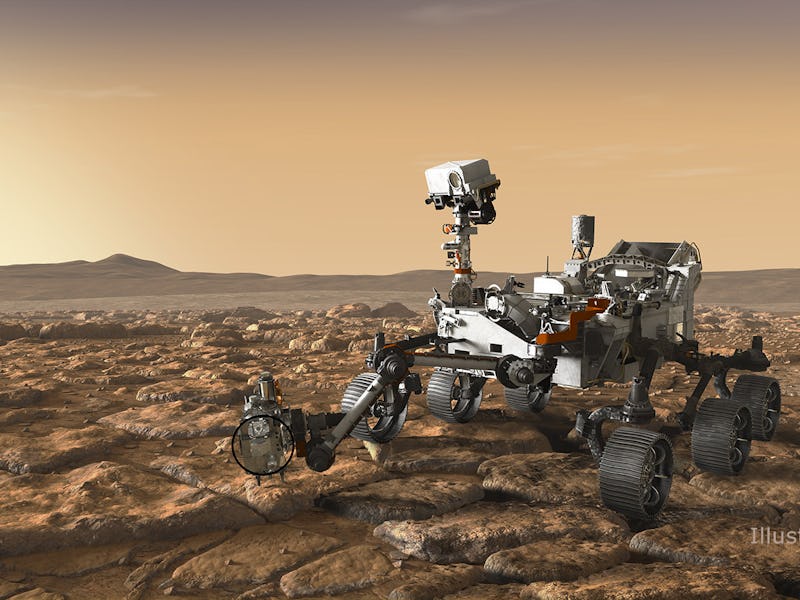50 days to launch: The Mars Perseverance rover must solve one big mystery
SHERLOC and WATSON will be investigating Mars' habitability.

This week marked the 50-day milestone until the launch window opens for NASA's Perseverance rover and its journey to Mars.
The car-sized robot is scheduled for a launch window of July 17-August 5, 2020 to Mars, and Perseverance's team of engineers are putting the final touches on the Martian rover which includes a detective duo that will scour the Red Planet for signs of ancient life.
The biggest mystery surrounding Mars is whether the now dry and desolate planet once hosted some form of life, and was considered habitable. For a cosmic case of this size, scientists need the help of the most iconic detective figure — or at least a robotic equivalent.
Enter S.H.E.R.L.O.C., (Scanning Habitable Environments with Raman & Luminescence for Organics & Chemicals) an instrument installed on the end of Perseverance's robotic arm that will look for microscopic clues in Martian rocks.
A close-up view of an engineering model of SHERLOC.
The instrument's primary objective is to seek out minerals and organic molecules that are considered to be the building blocks of life here on Earth.
But of course, what would this version of the famous detective be without its sidekick.
The Wide Angle Topographic Sensor for Operations and eNgineering instrument, or WATSON, will be right by SHERLOC's side.
SHERLOC has an auto-focusing camera that shoots black and white images, while WATSON is a color camera that will zero in on the textures of the rocks.
SHERLOC also has a laser, which aims for the center of rock surfaces that will be revealed in WATSON's images.
The laser uses a technique known as Raman spectroscopy after Indian physicist C.V. Raman, who discovered the light-scattering effect in the 1920s. This technique can help scientists detect minerals in microscopic rock features by identifying different molecules based on their unique spectral "fingerprint" that will be visible in the light they emit.
"Life is clumpy."
"Life is clumpy," Luther Beegle, SHERLOC's principal investigator, said in a statement. "If we see organics clumping together on one part of a rock, it might be a sign that microbes thrived there in the past."
As Perseverance rolls its way along the Martian surface, the team behind the rover will be on the lookout for interesting rocks. They will then send commands to the rover to pick it up, and scan a quarter-sized area of it using SHERLOC's laser before taking a close-up image of the sample using WATSON.
A test image captured by the SHERLOC instrument, with each different color representing a mineral detected on the rock.
Using this data, the team will be able to map SHERLOC's findings over WATSON's images to help reveal how different layers of minerals formed and overlapped over one another in the rock samples.
SHERLOC will be working with six other instruments onboard Perseverance, including PIXL (Planetary Instrument for X-ray Lithochemistry) on Perseverance's robotic arm, to look for signs of fossilized microbial life in Martian rocks.
But rocks are not the only thing WATSON will be snapping pictures of. WATSON can also be used to take selfies of Perseverance using its robotic arm. NASA's Martian rovers are famous for showing out in a series of selfies with a backdrop of the Red Planet behind them.
NASA's Curiosity rover is a master of taking selfies.
Once it lands on Mars in February, 2021, Perseverance will join Curiosity rover, which landed on the Red Planet back in August, 2012, and is still roaming the Red Planet to this day.
NASA previously sent two other rovers to Mars, Spirit, and Opportunity, which landed on the Red Planet in January 2004.
Perseverance will look for signs of habitability on the Martian surface and past microbial life, collecting samples of rocks and soil and setting them aside for a future mission to return them back to Earth.
The mission will also test out conditions for possible human exploration of Mars by trialing a method of producing oxygen from the Martian atmosphere, characterizing environmental conditions such as water and dust on Mars, and looking for resources.
Perseverance rover is set to spend at least one Martian year on the planet — the equivalent of 687 days on Earth.
Now read this: As NASA's biggest mission in years looms, its engineers are forced to get creative
This article was originally published on